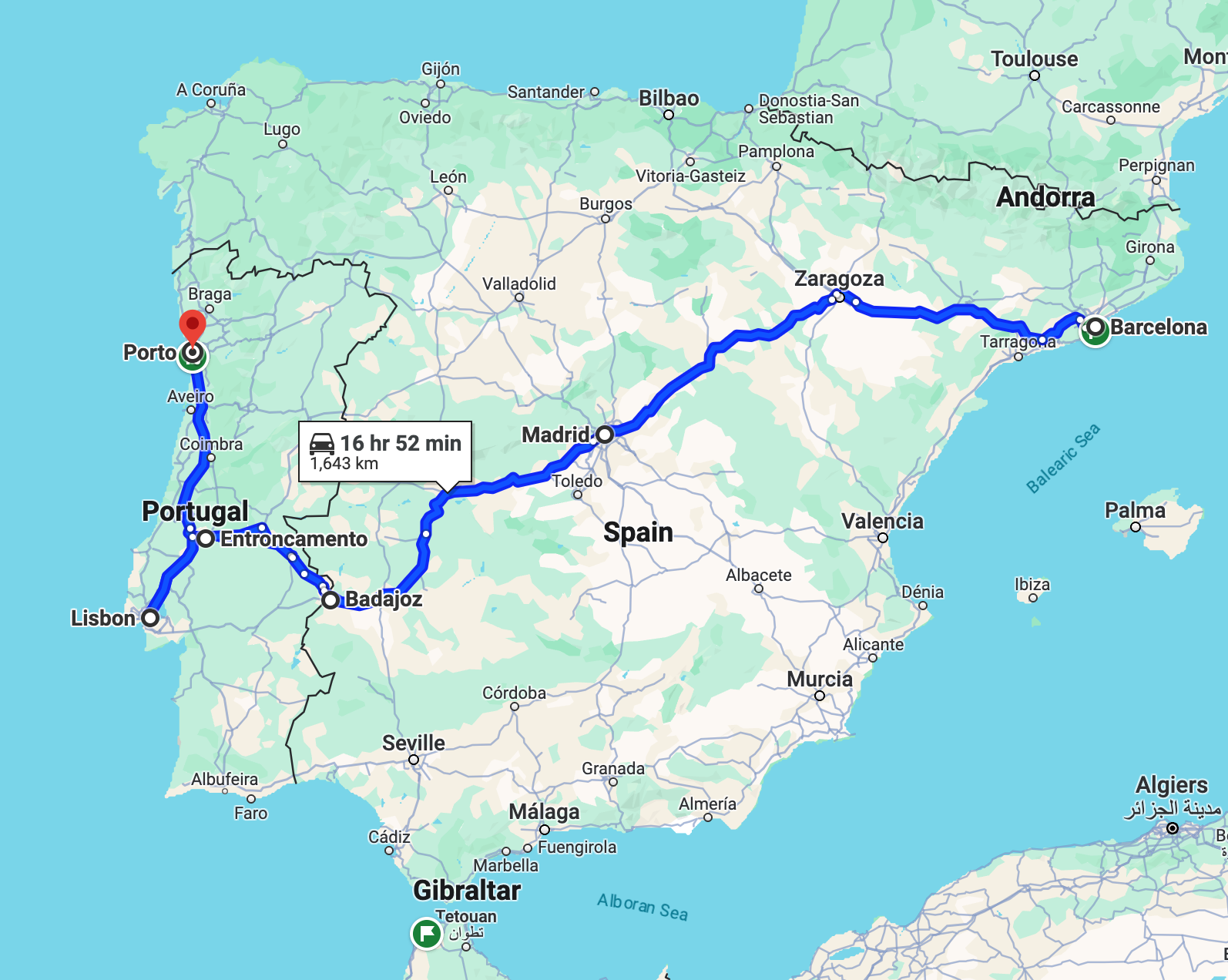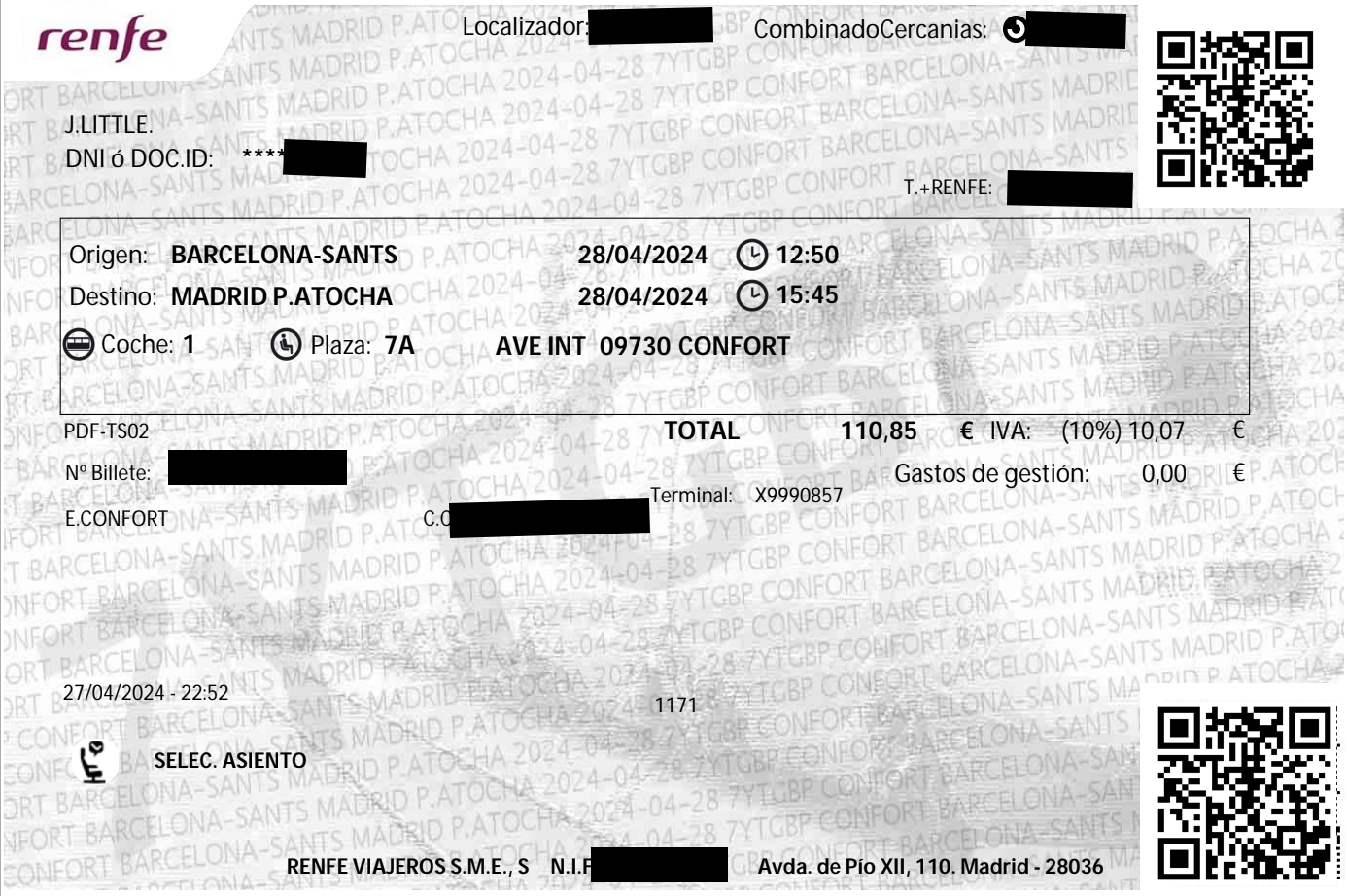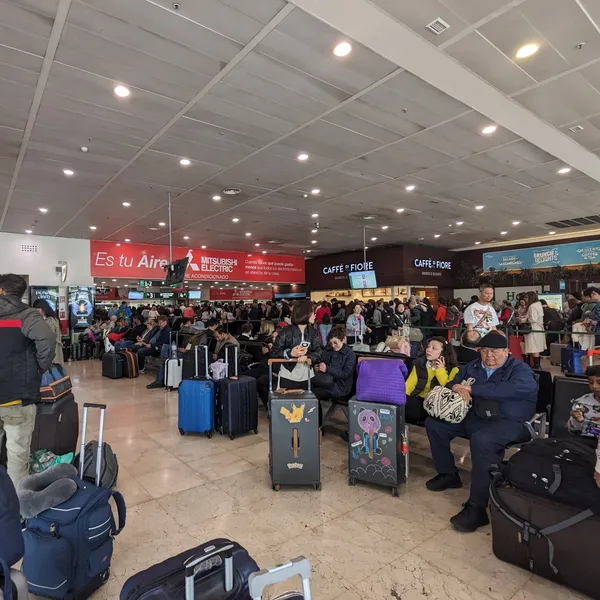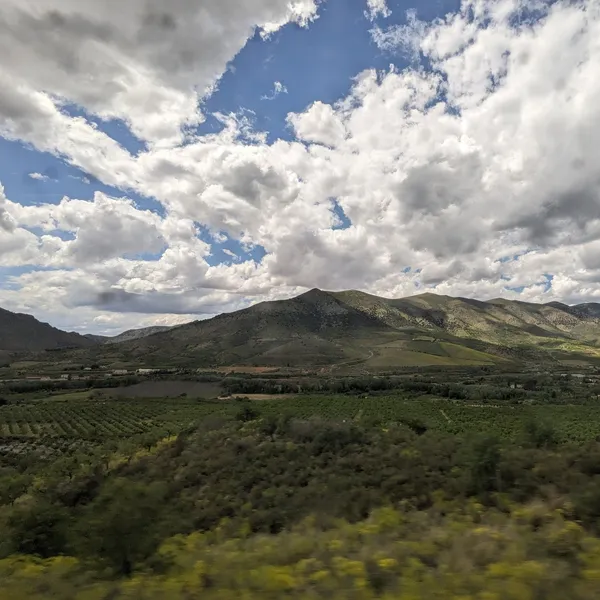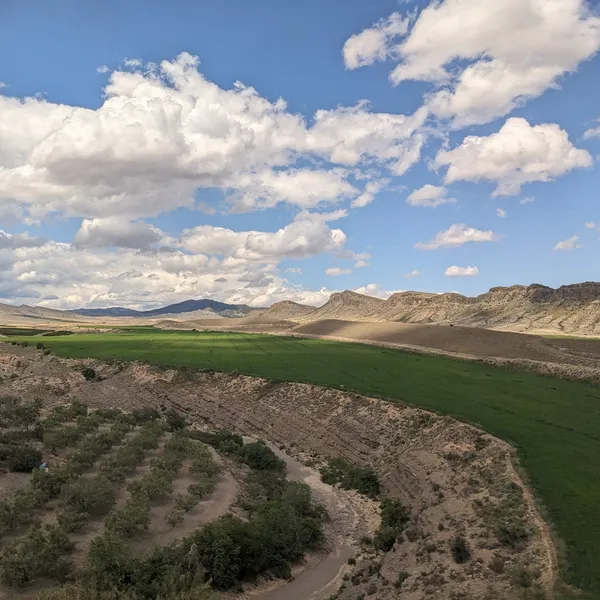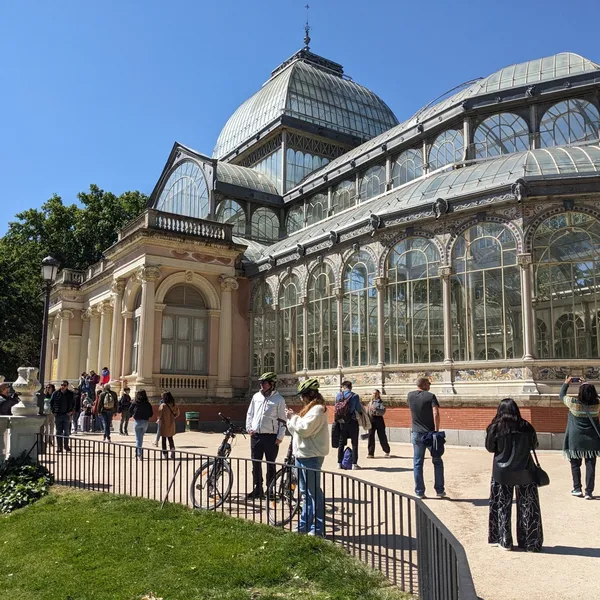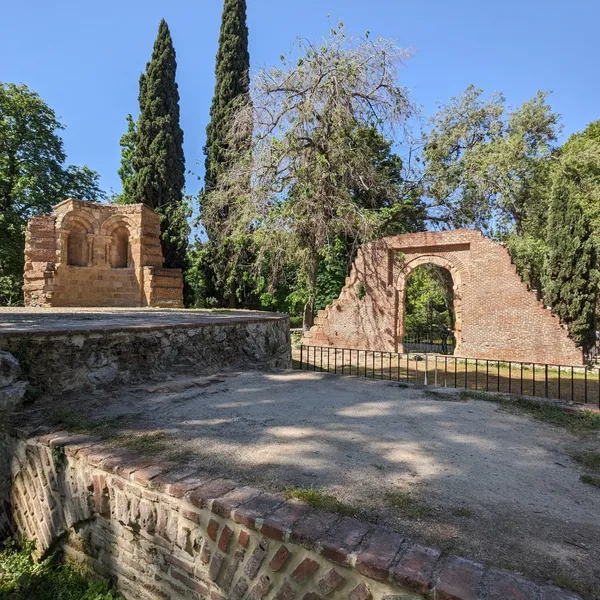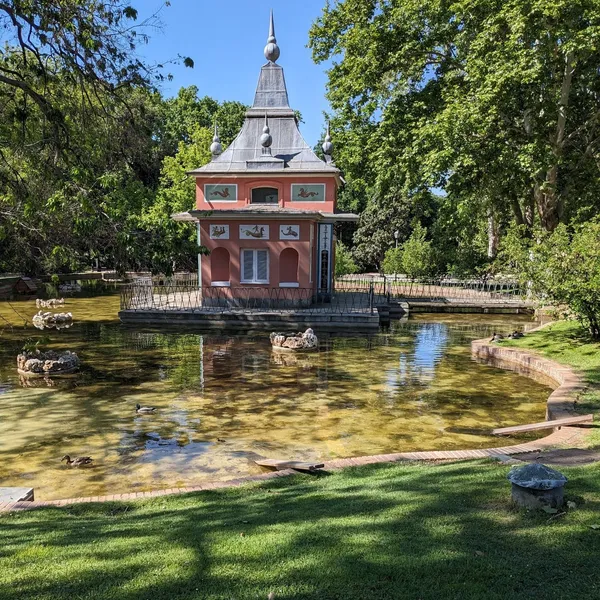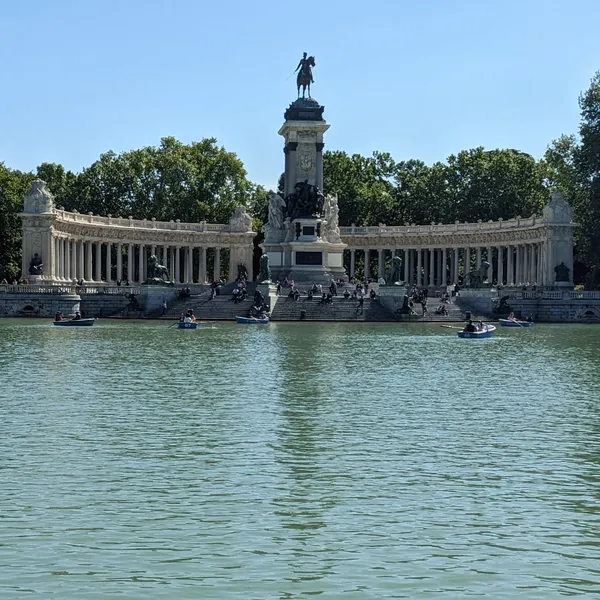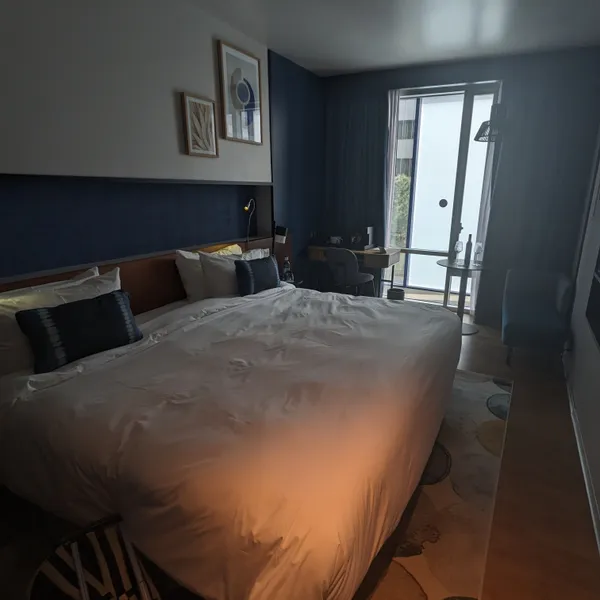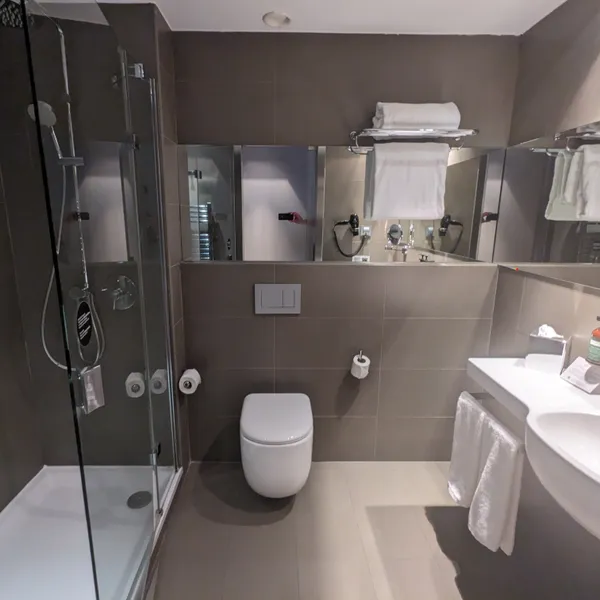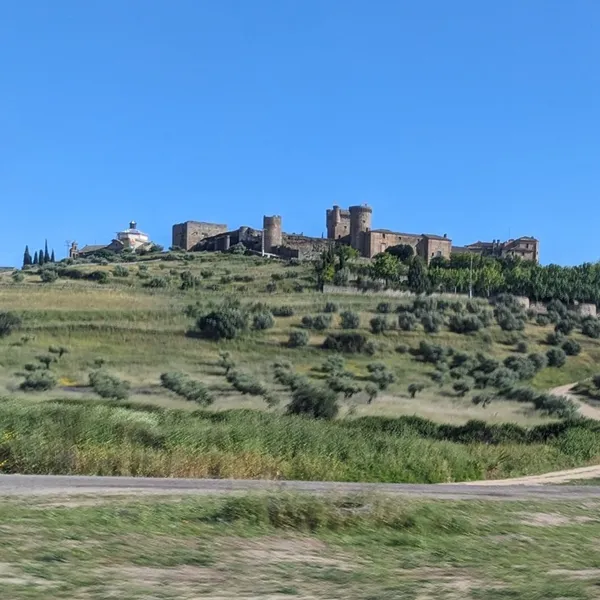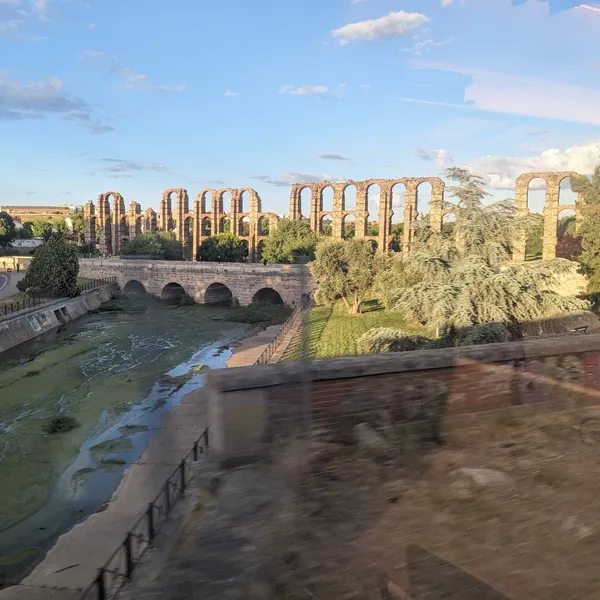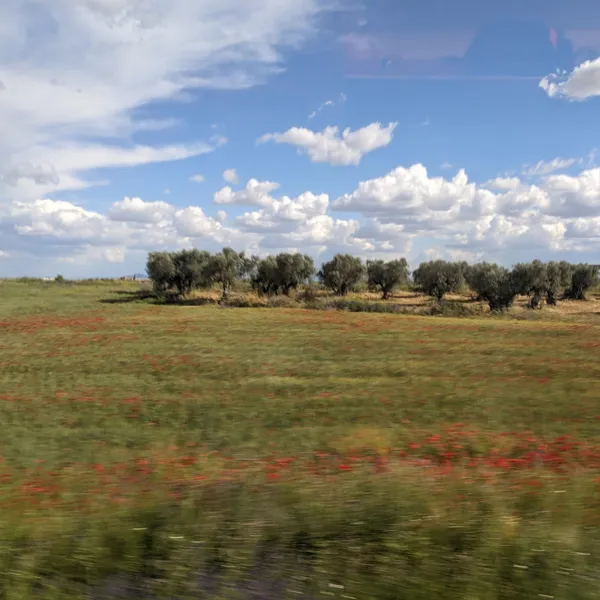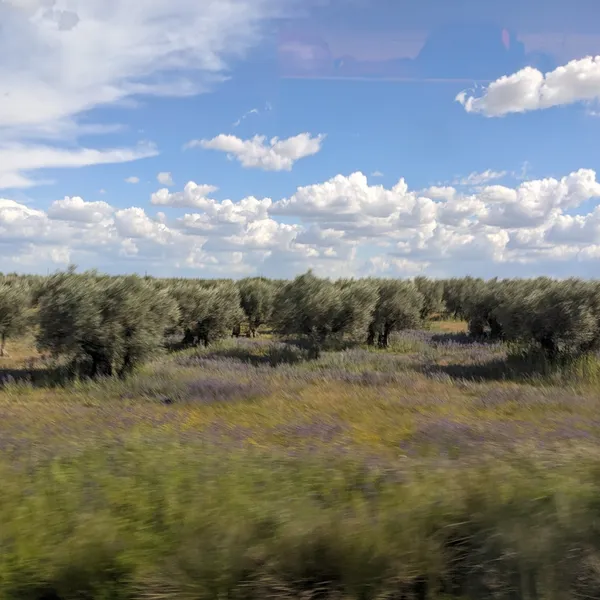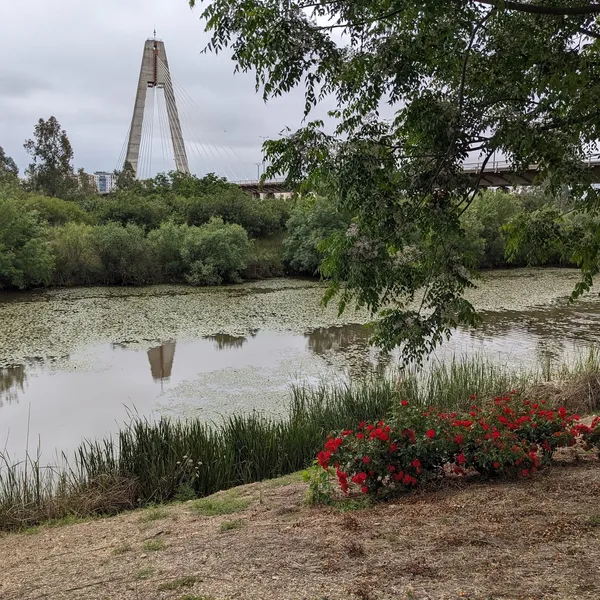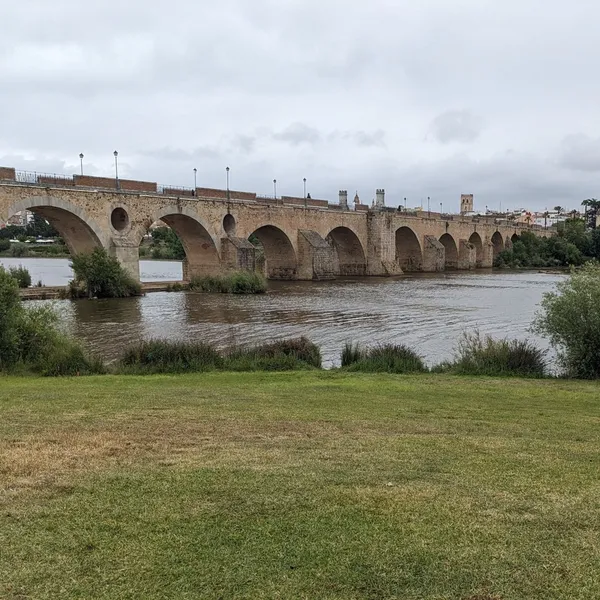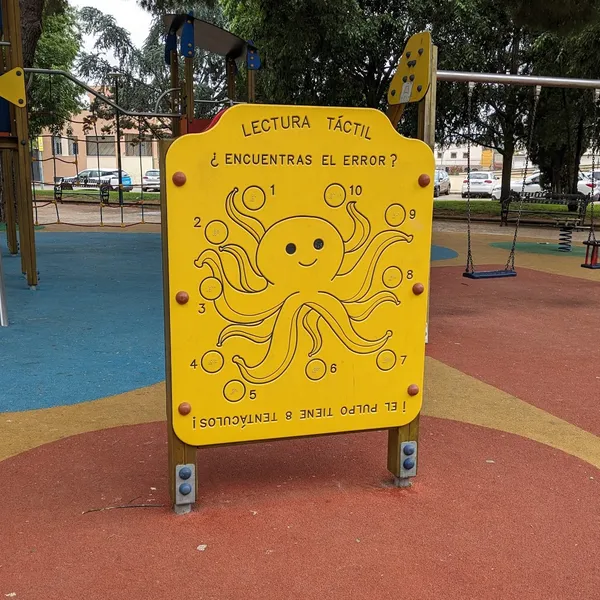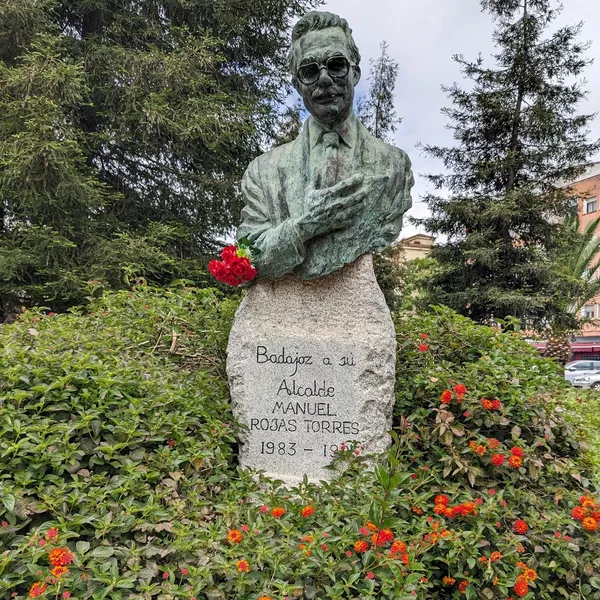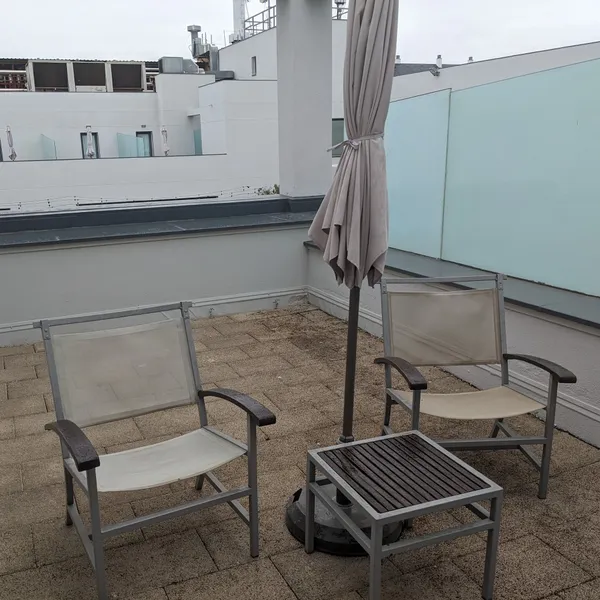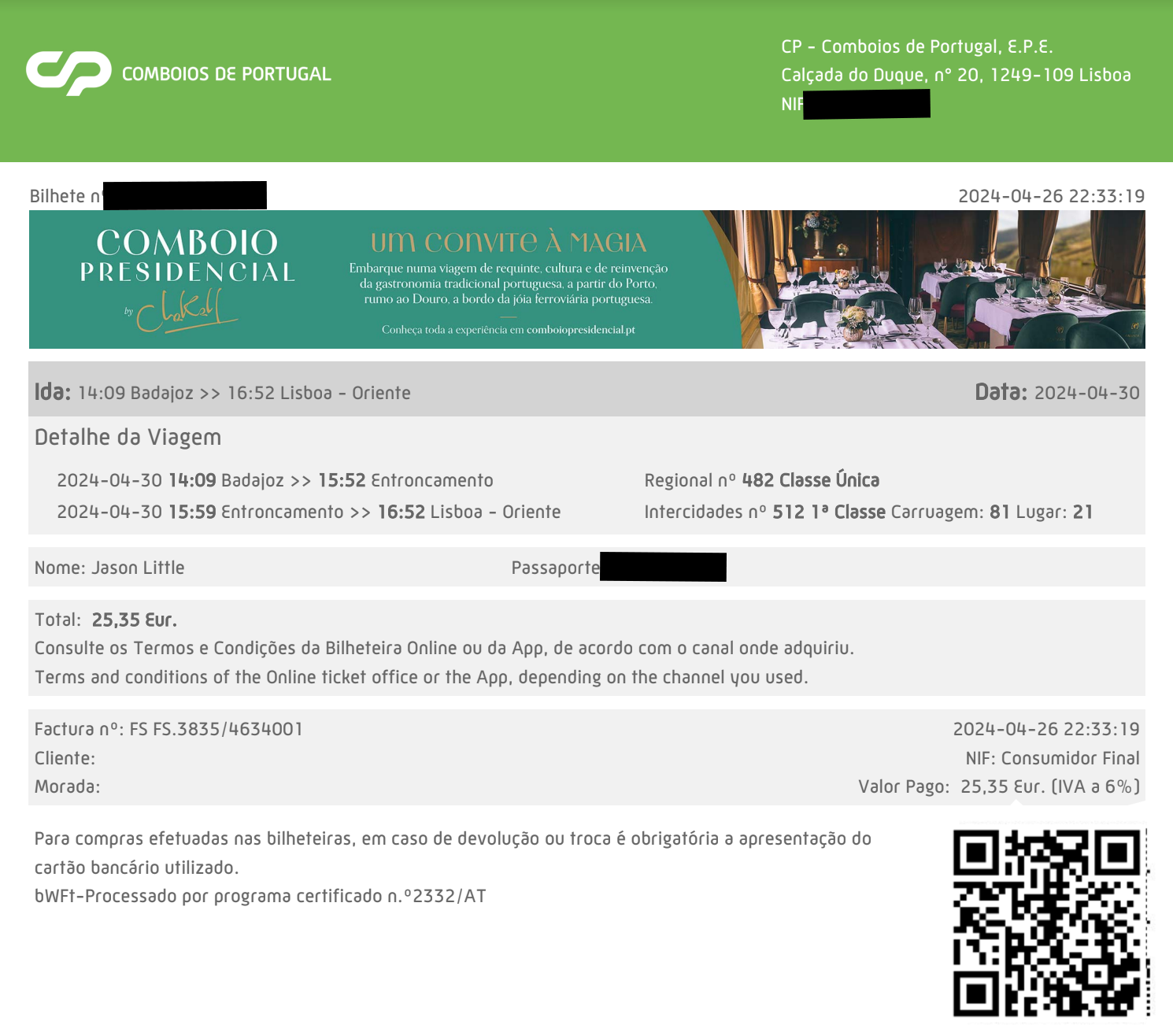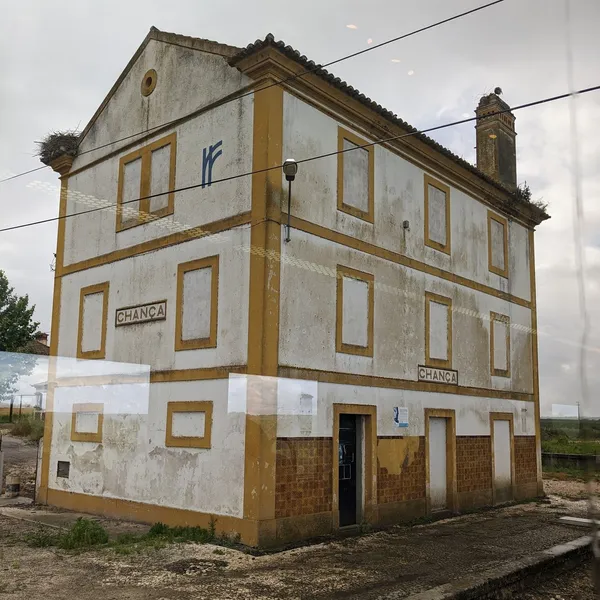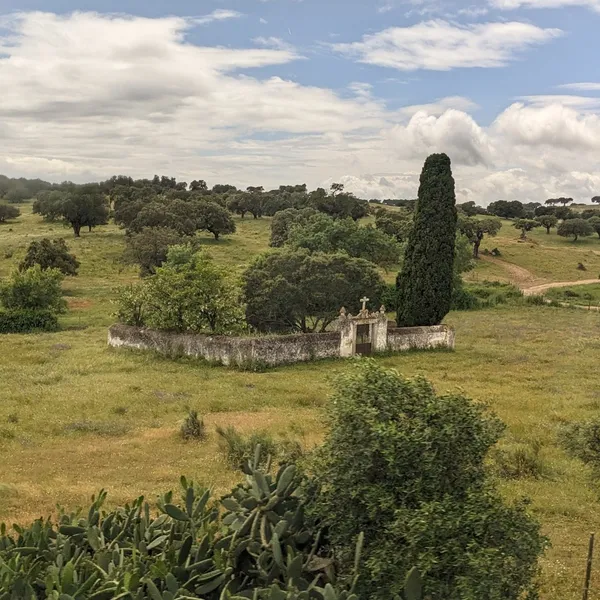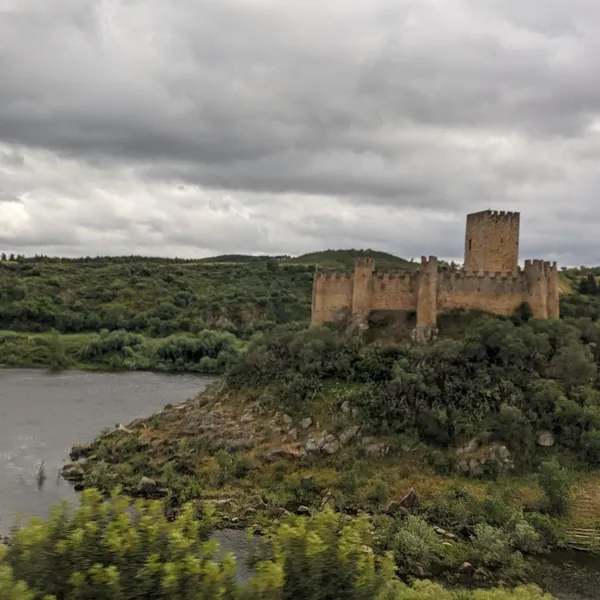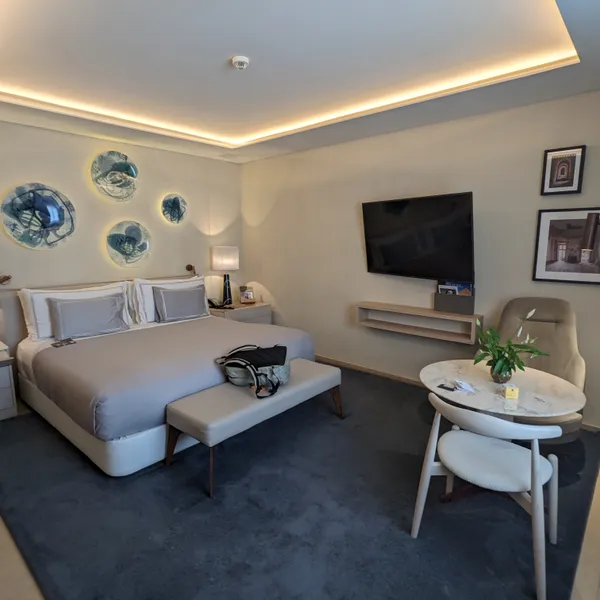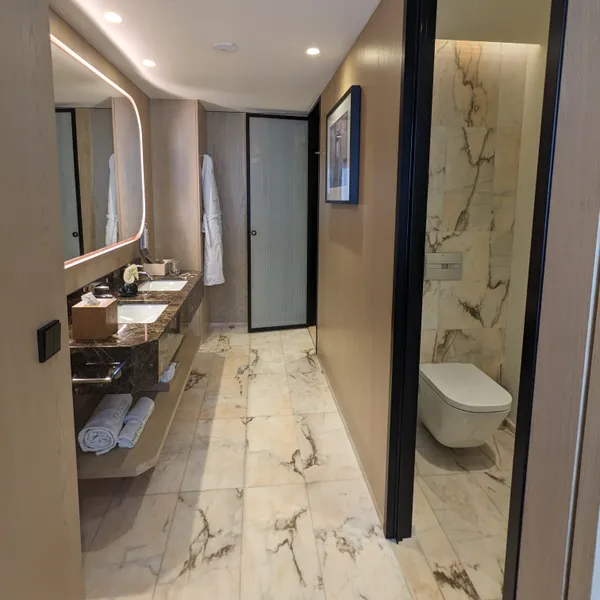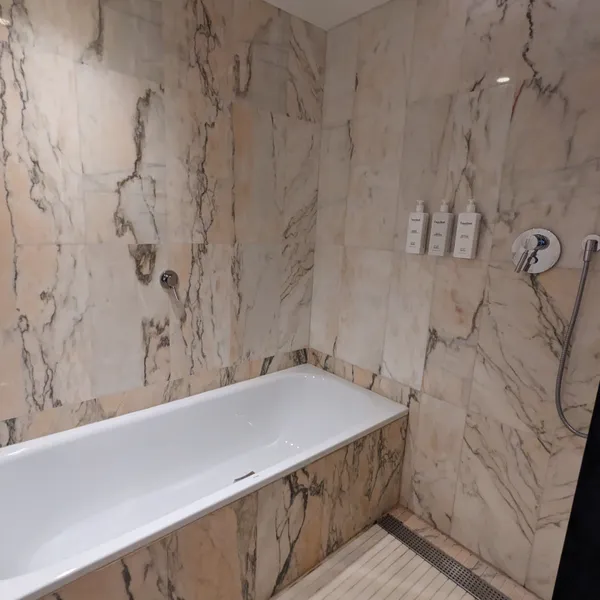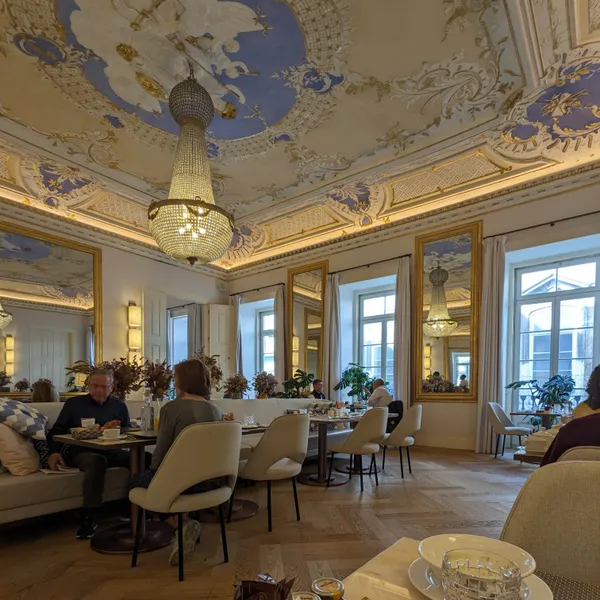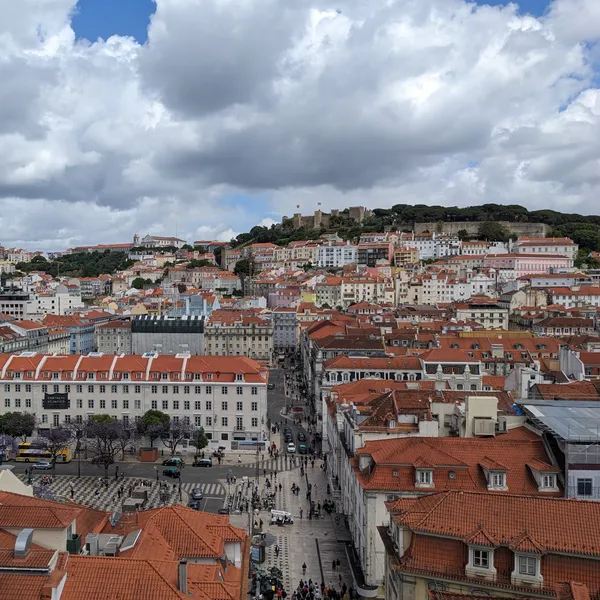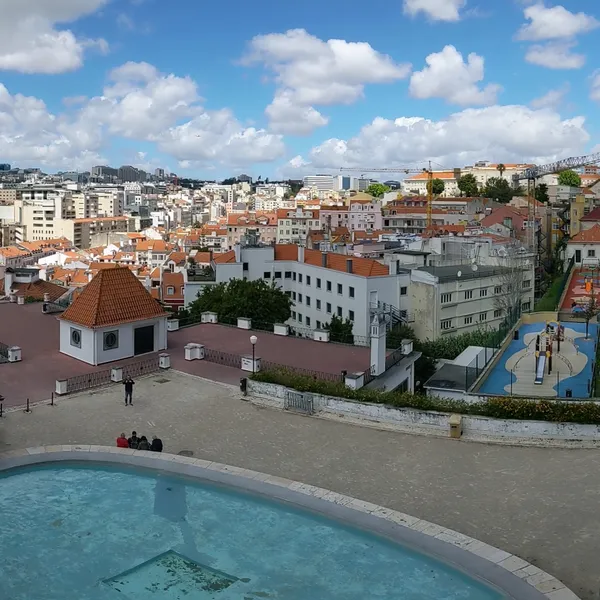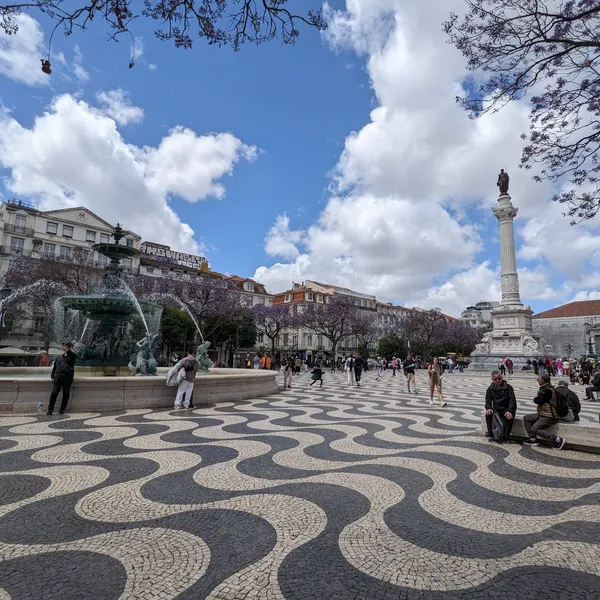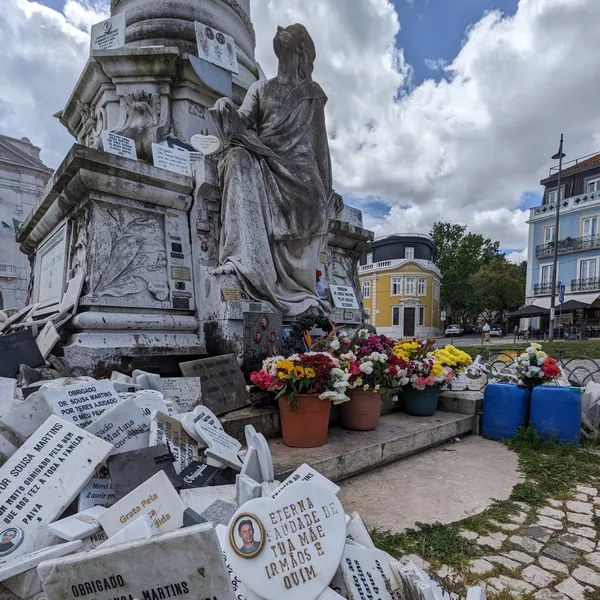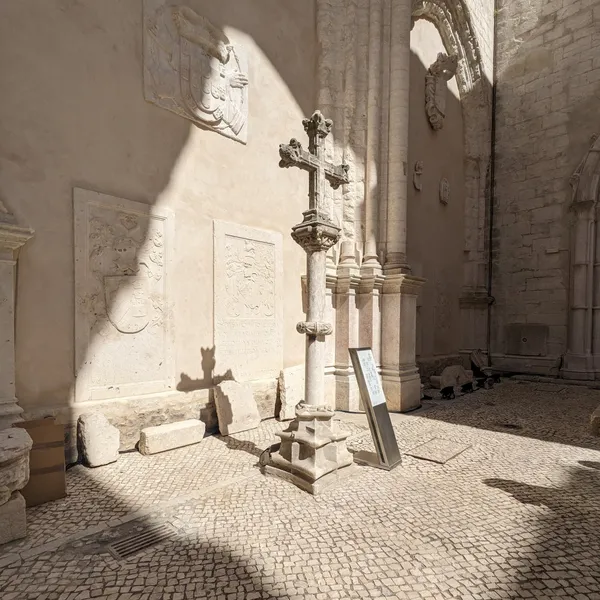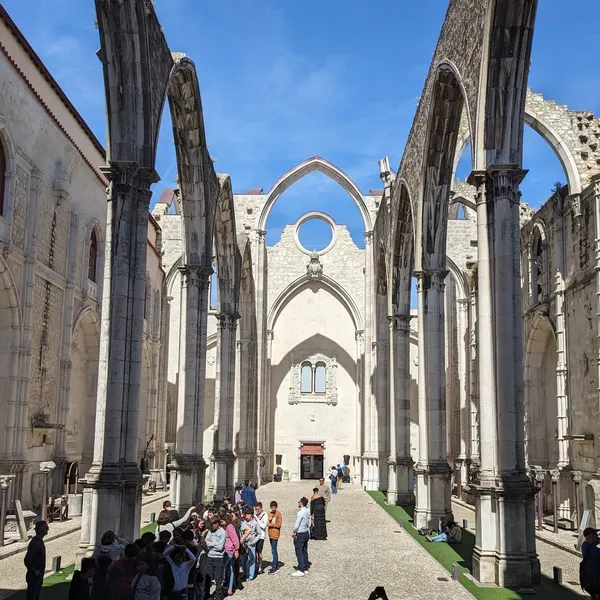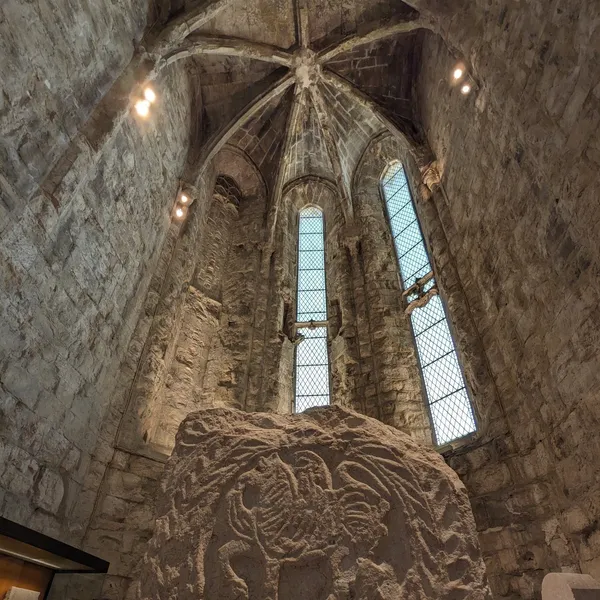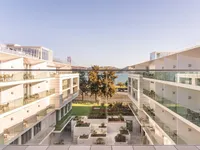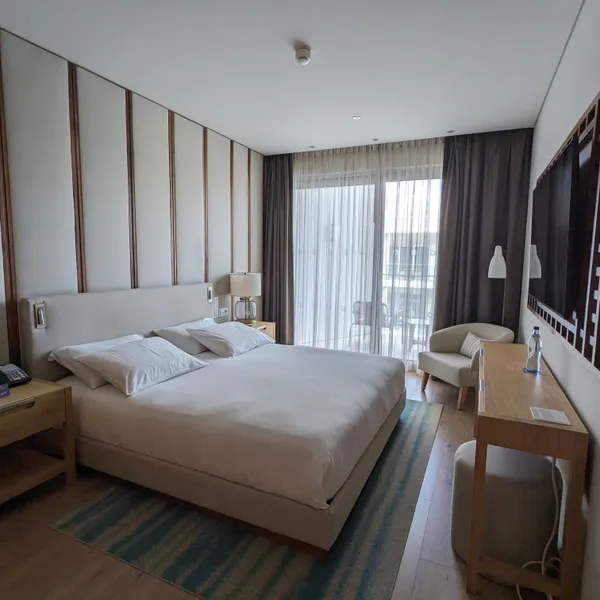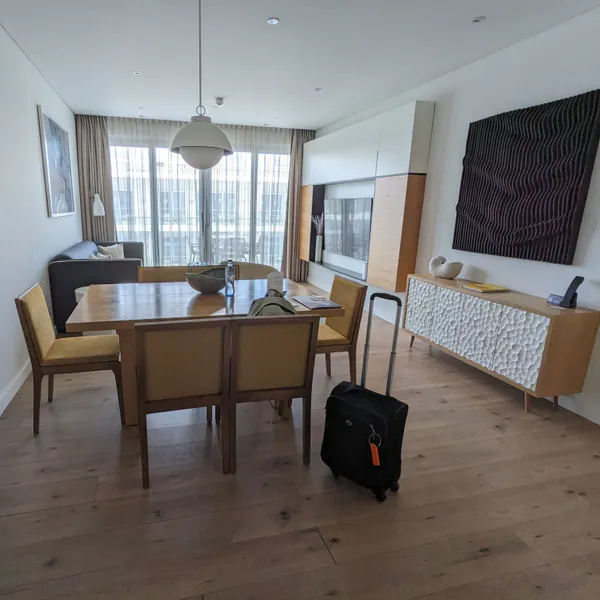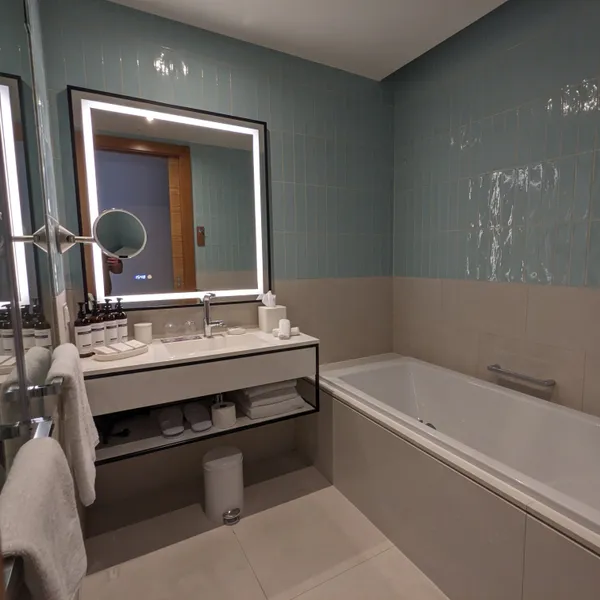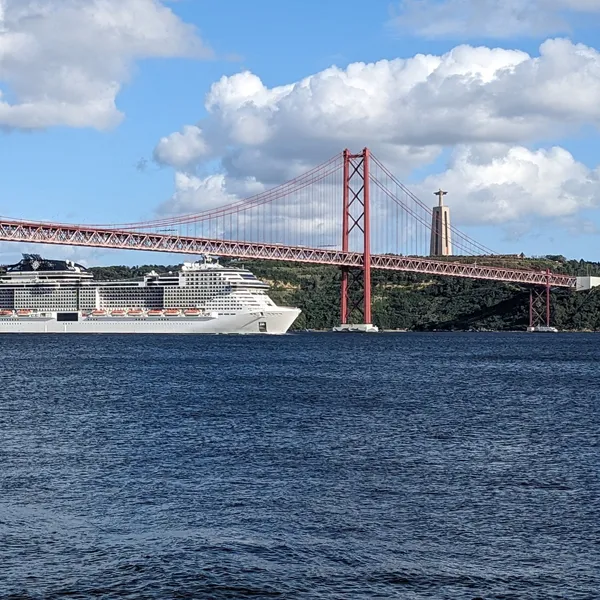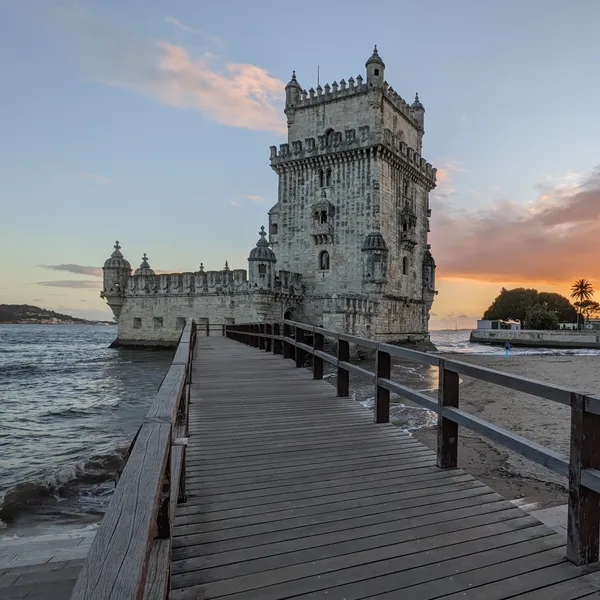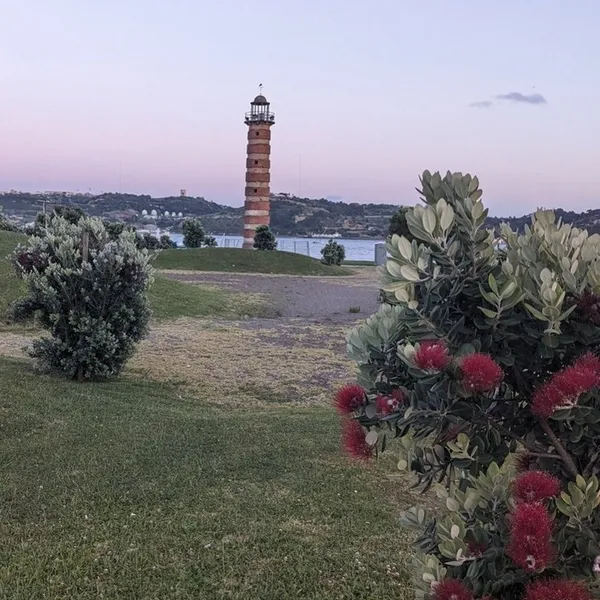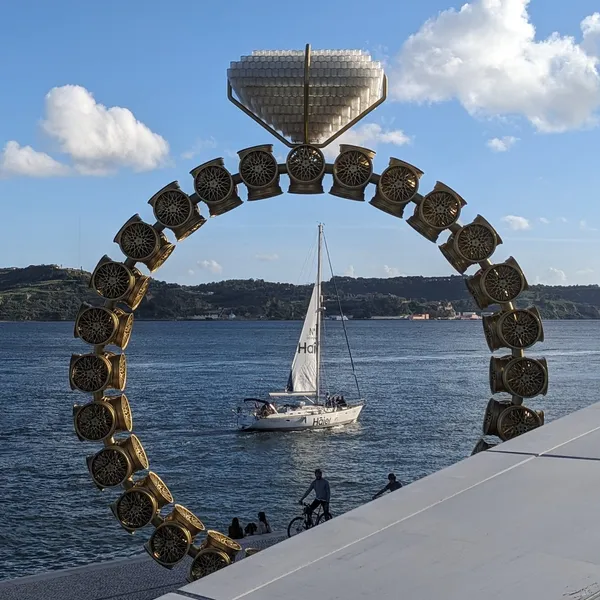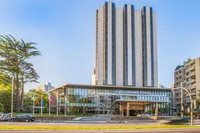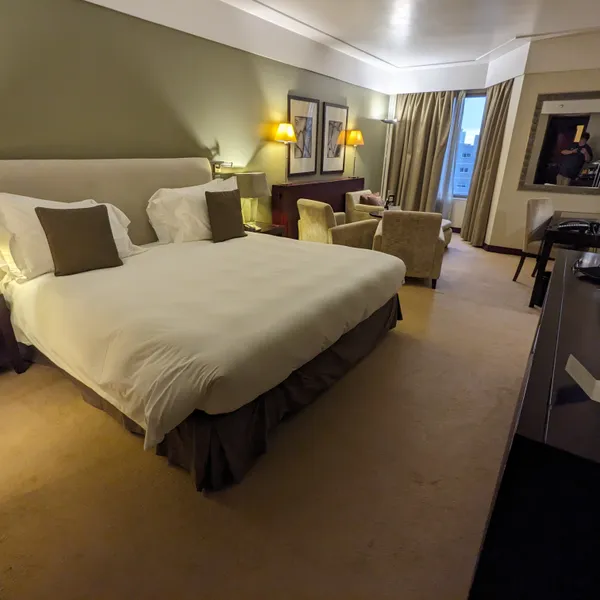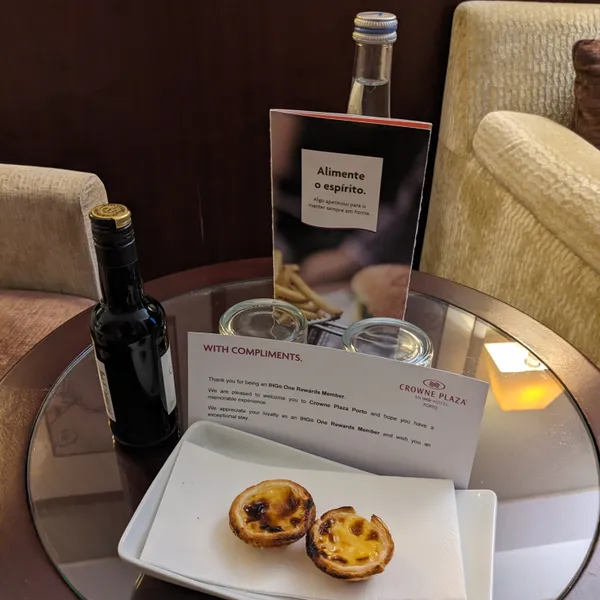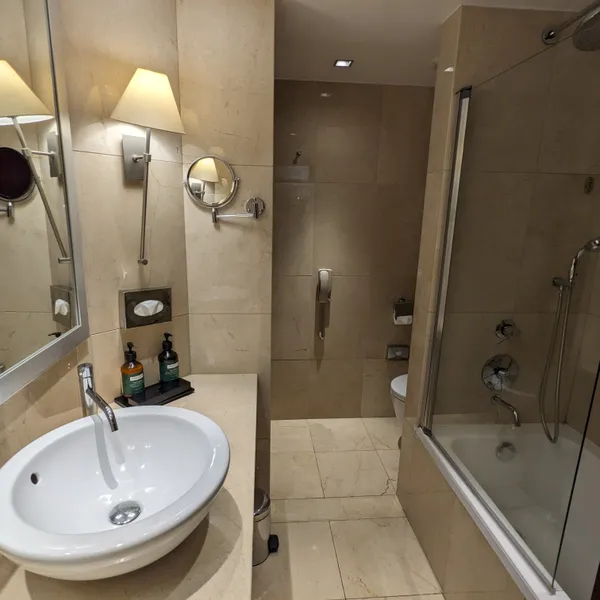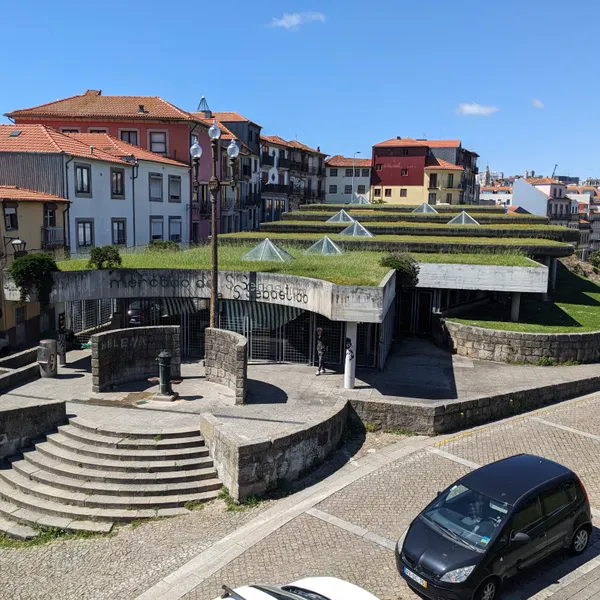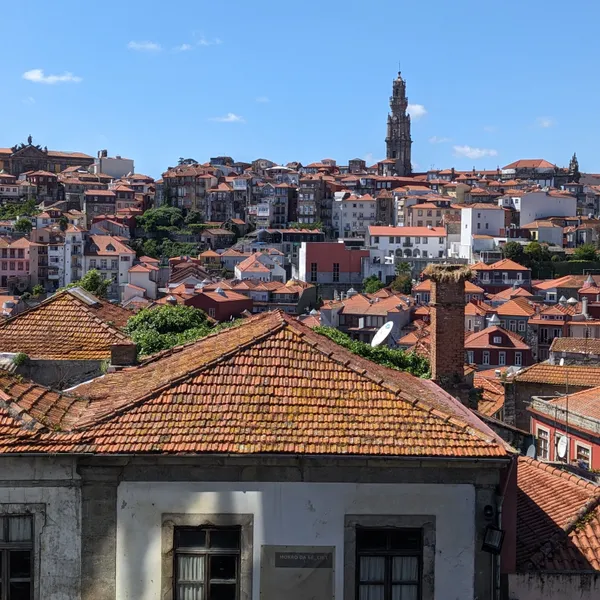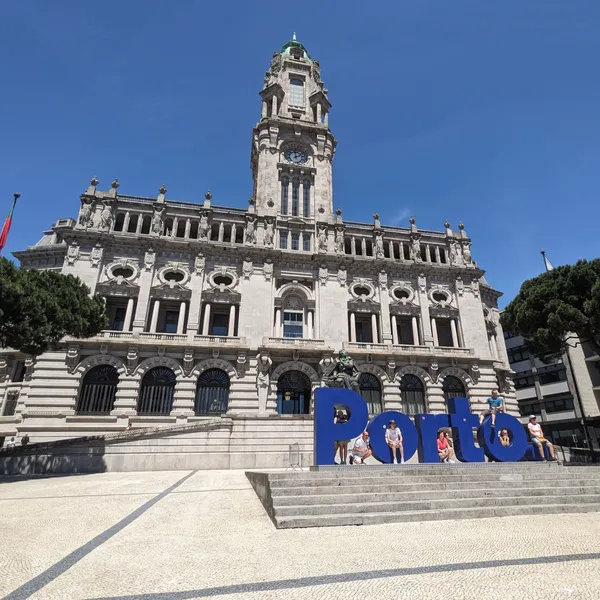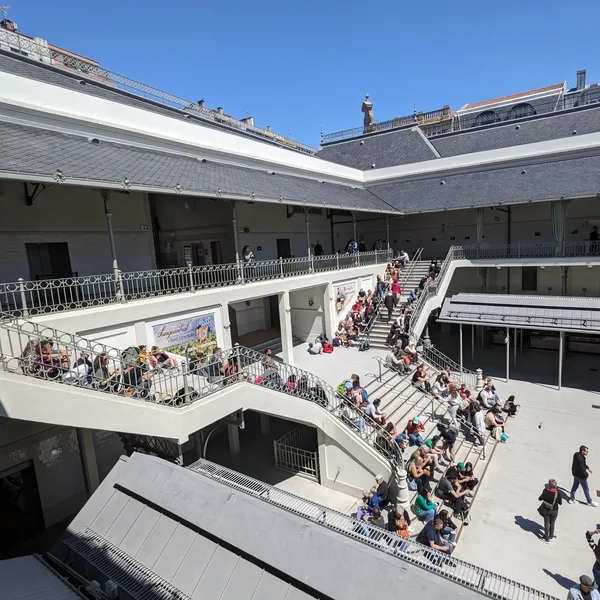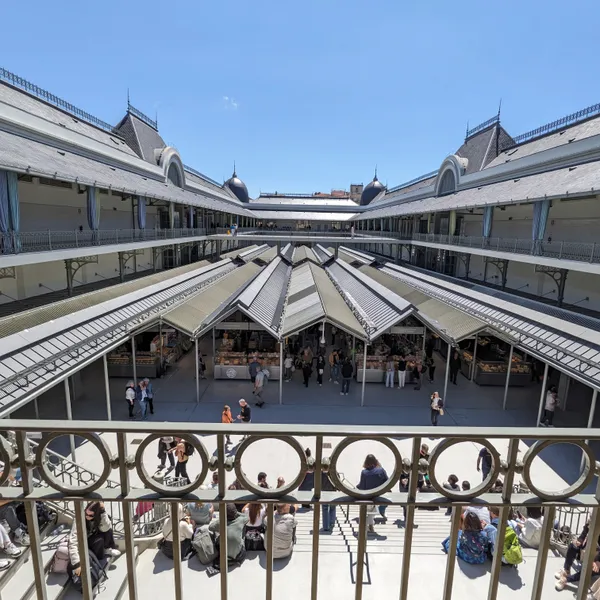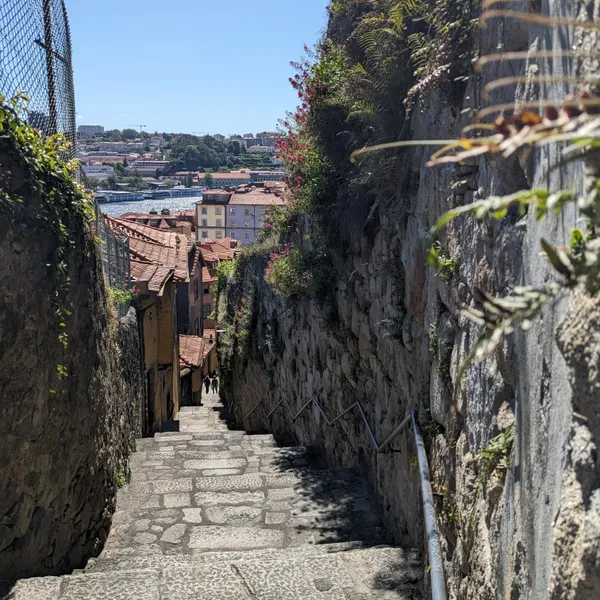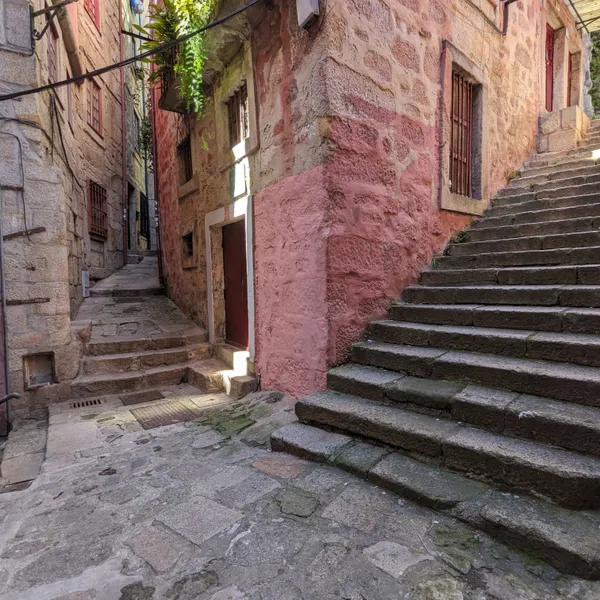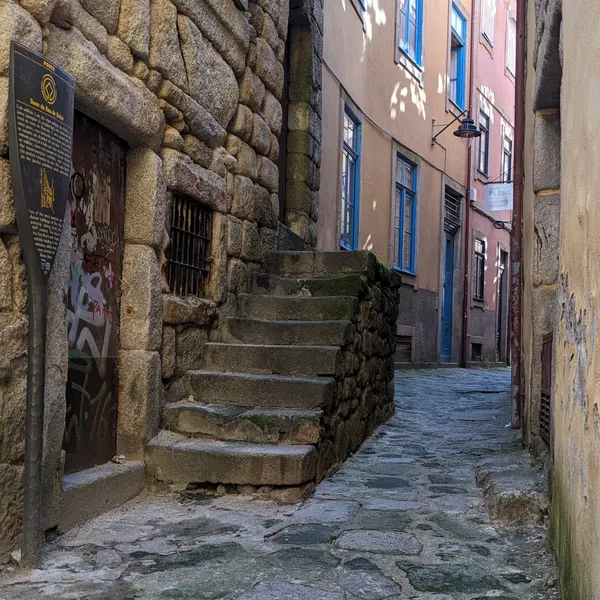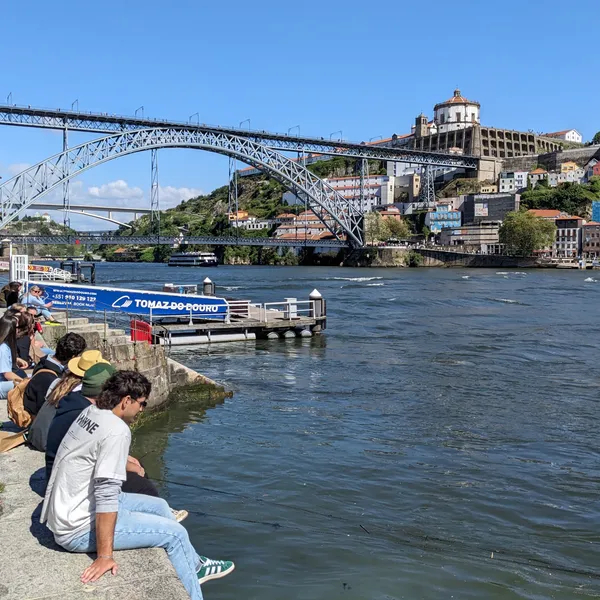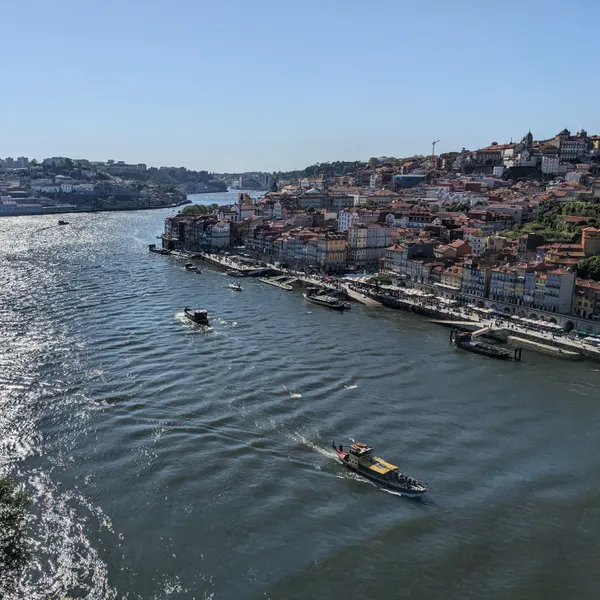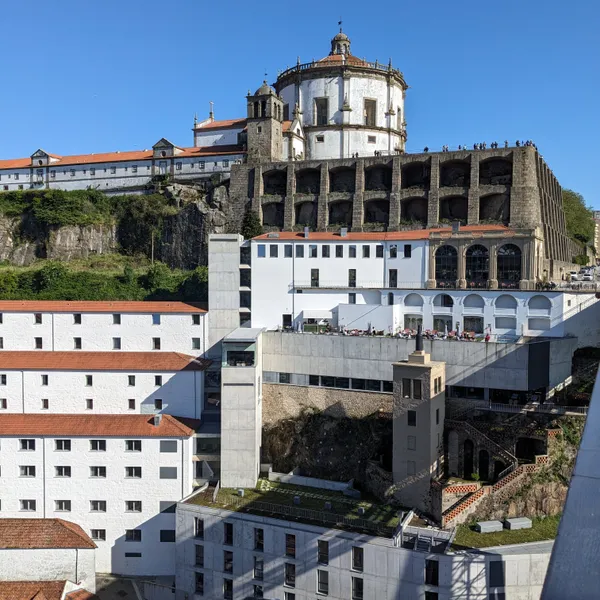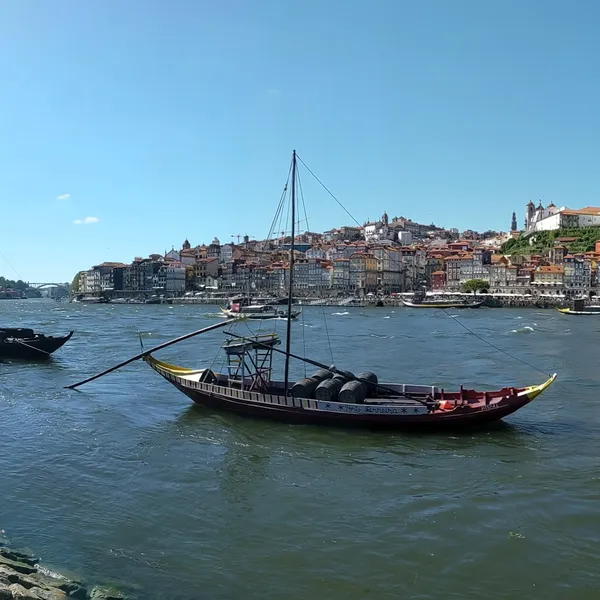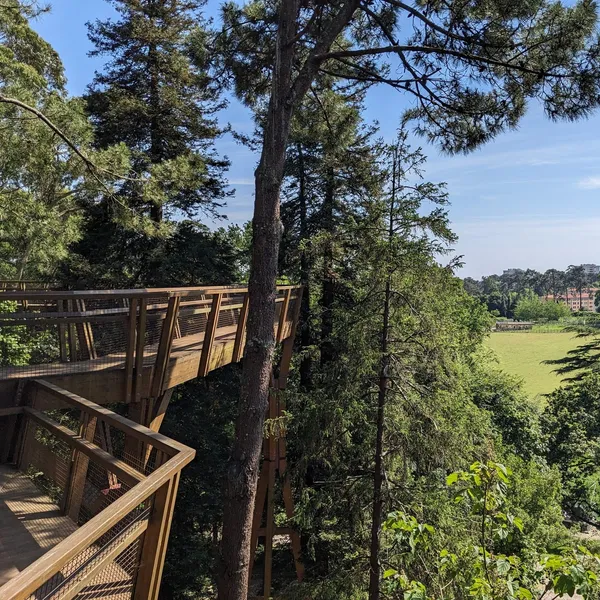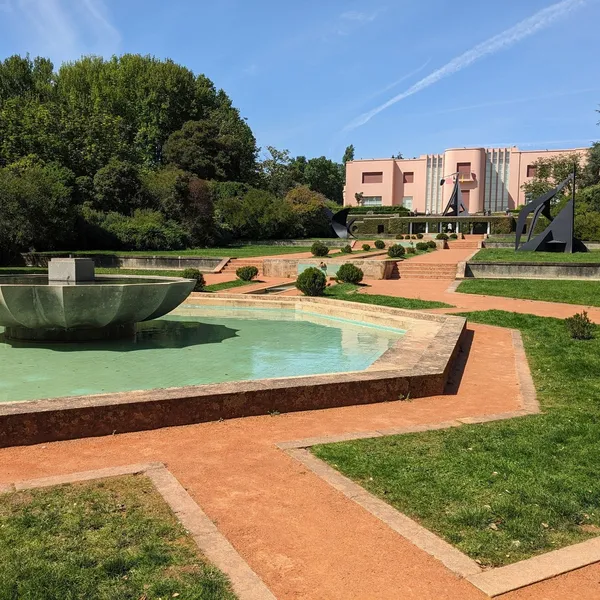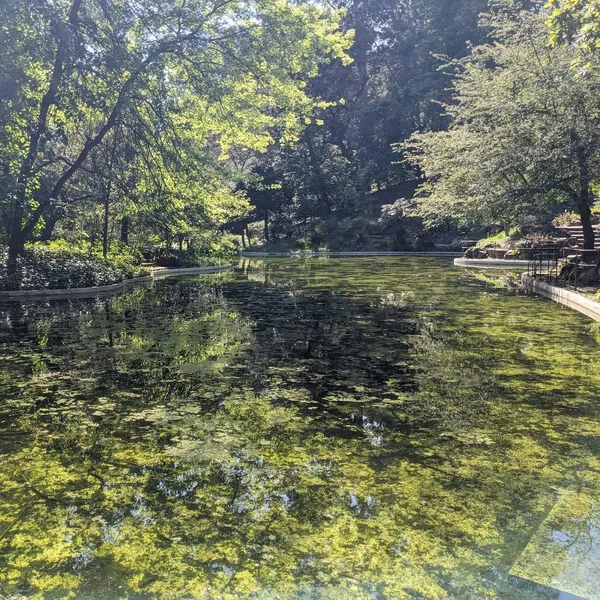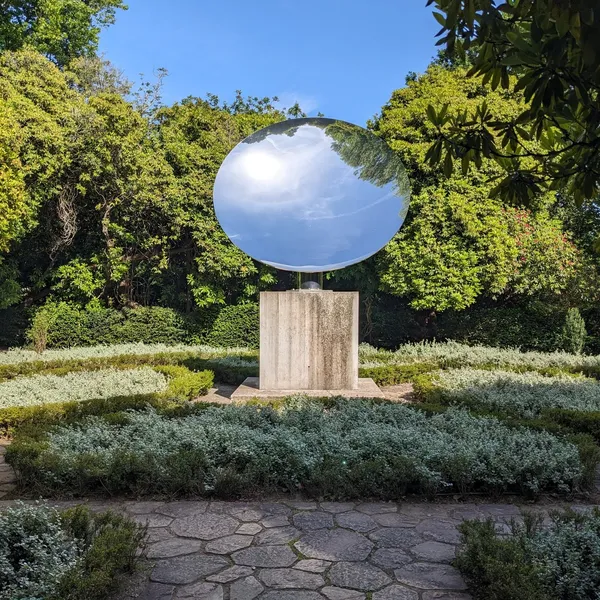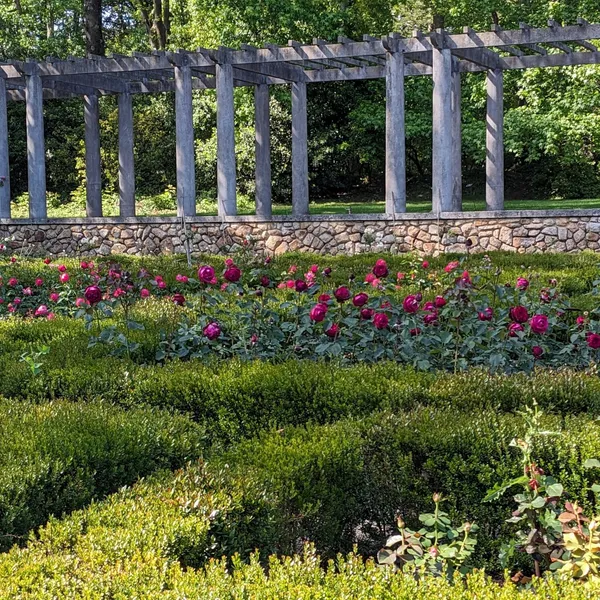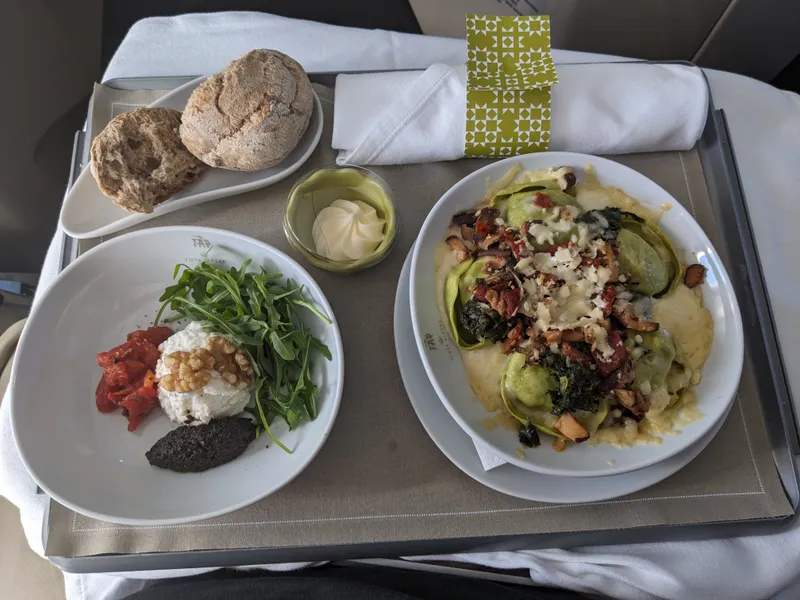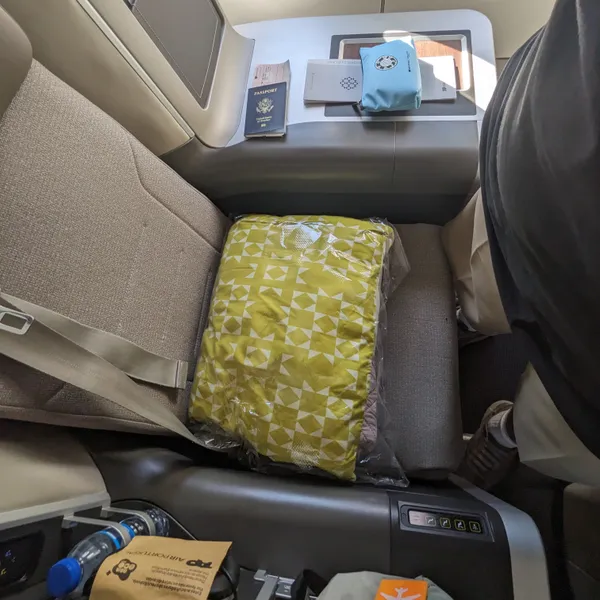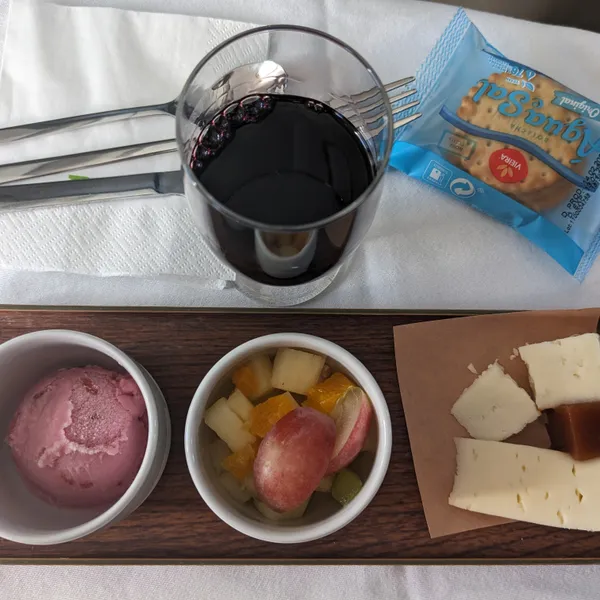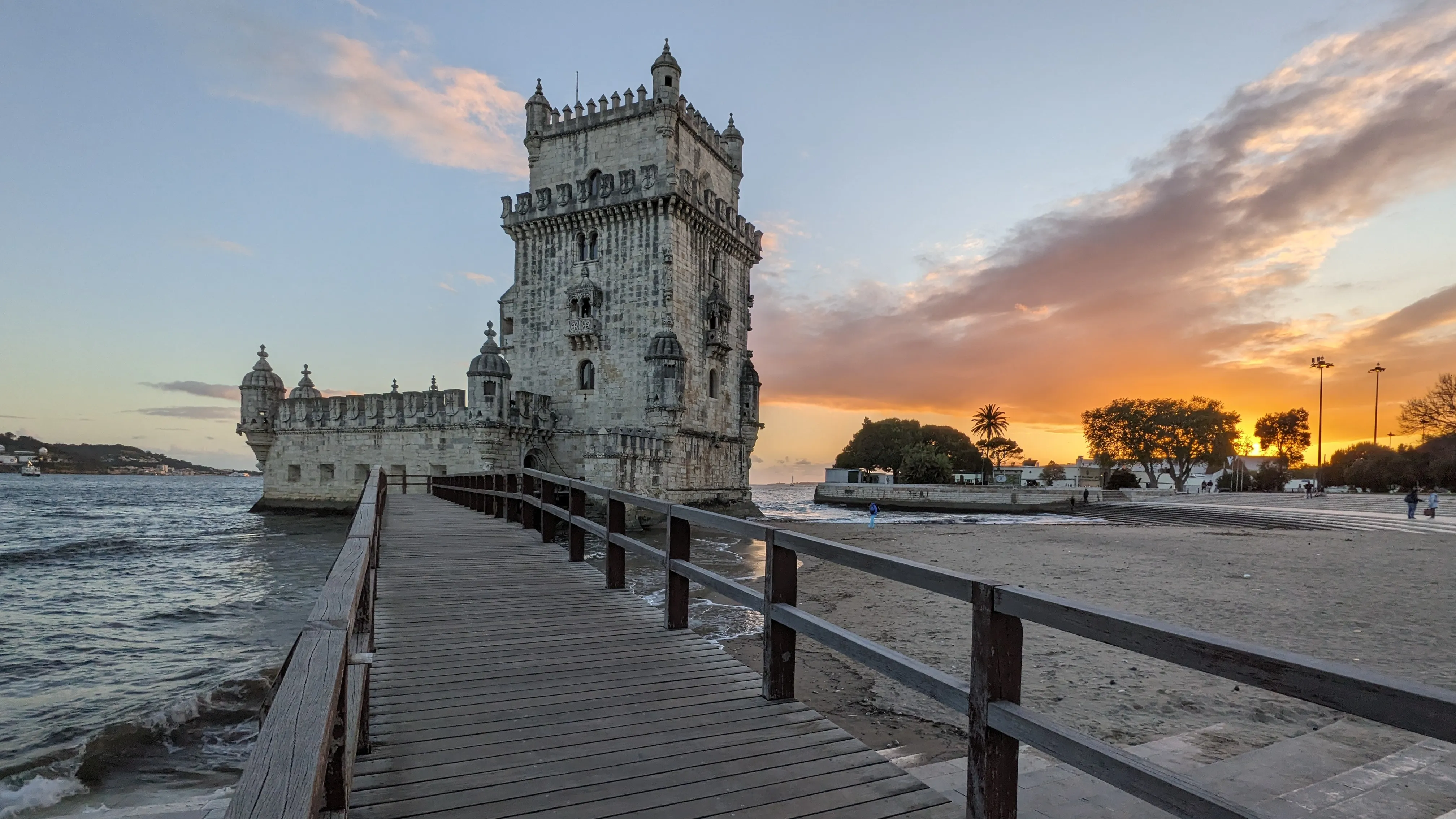
Spain and Portugal by Train
This is part two of a two part trip.
- Part 1: Sailing from America to Spain’s Gold Coast
- Part 2: Spain and Portugal by Train
Introduction
When we left off in part one, we’d just completed a cruise sailing from Norfolk Virginia, to Barcelona Spain, ending with a night in Barcelona.
For this trip, I had a few criteria.
- Visit Barcelona, Madrid, Lisbon and Porto.
- Travel by train to see the countryside and experience high speed trains.
- Use points everywhere except for the trains.
I specifically wanted to avoid taking any short flights in Europe as business and first typically get the same physical seats as those in economy. They’ll sell you a more expensive fare, but it’s just about service.
We start with the train ride from Barcelona to Madrid.
Spain
Renfe AVE from Barcelona to Madrid
For the journey from Barcelona to Madrid, I booked a $120 first class “confort” ticket on Renfe’s high speed AVE line. These trains travel up to 186 mph and the journey was scheduled to take just under three hours with a couple of stops along the way. The first class seats were arranged in a 1-2 configuration with some seats facing backwards, often with a table in between.
I arrived at the Barcelona Saints station about 40 minutes prior to departure. During the trip, this was the only station to feature a full security checkpoint with baggage scanning. Even so, getting through was a breeze and a few minutes later I was past security, standing in a queue with other passengers waiting for the assigned track to be opened for our train.
Compared to other stations, Barcelona Saints had by far the best process and clearest signage for international passengers. I particularly appreciated how the track was posted early and how the floor had painted directions to guide passengers from the security check point to the correct queues. Thirty minutes would have been plenty of time.
Once aboard, the seats were very comfortable, a little better than you’d find in a domestic airline’s first class. The ride was very smooth and I spent the trip watching the mountains, farms and plains zoom past. This region is broadly known as the Meseta Central or the central plateau and has a semi-arid climate.
Madrid
I arrived late in the afternoon and spent this day and most of the next exploring central Madrid and the Retiro, which is a bit like its Central Park. Retiro was originally built in the 1500s, for the nobility. It didn’t become public until the mid to late 1800s.
The park consists of a network of interconnected plazas, ponds and gardens, with unusual buildings, statues and fountains mixed in throughout. There seemed to be a plaza for every notable Spanish colony, Panama, Puerto Rico and more.
For my one night in Madrid, I stayed at the Crowne Plaza Retiro to the east of the park. The hotel was fine, but it was a bit of a hike from the train station. In retrospect, something to the west may have been better for sightseeing.
Crowne Plaza Madrid Centre Retiro
A great hotel near removal and the exclusive Salamanca district, just minutes away from the "art walk" with the emblematic museums in "El Prado", "Reina Sofía", or the "Thyssen Bornemisza". A stunning complex comprised of two buildings, pleasant gardens, art gallery, restaurants, gym and private parking.
Renfe Alvia from Madrid to Badajoz
Getting from Madrid to Lisbon requires three trains with the first being an Alvia from Madrid to Badajoz on the border with Portugal. I booked another first class “confort” ticket, for $125, again in a 1-2 configuration. The Alvia train was comparable to the AVE, perhaps a little older and a little slower, but still high speed at 155mph.
The plan was to leave Madrid in the late afternoon, arriving in Badajoz around sunset, hopefully getting some spectacular views along the way. As we traveled west, the land changed from arid, to fields full of yellow, green and red flowers, to green hills and mountains.
Along the way, we passed Castillo de Oropesa, home to the Toledo nobles, built in 1402. A little closer to Badajoz, we got to see the Aqueducts of Mérida as we entered the station and again as we backed out, reversing the train’s direction for the rest of the trip. These were built around the 1st-3rd century AD and were dubbed the “Aqueduct of the Miracles.”
Badajoz
I arrived in Badajoz around 9pm and would be leaving the next day around noon. This was more an artifact of me pushing for more time in Madrid, worrying about the connection in Entroncamento and wanting to arrive in Lisbon while it was still light. Had I known more about the history of Badajoz, I likely would have stayed there another night, or split time between Badajoz and nearby Mérida.
There is evidence of occupation around Badajoz going back 4,000 years. The Romans conquered it during the Second Punic wars circa 200BC. The Moors controlled the city from the 8th to 11th centuries, and you can see examples of the architecture everywhere. Later, as European wars heated up, the region changed hands several times.
Another reason to stop in Badajoz is that I was able to book an AC Marriott for just 9,000 points, a third the price of the cheapest Marriott in Madrid. While there, I met another American traveling by train in the reverse direction, and she was able to give me tips on the routes to Lisbon and Porto. She had been trying to get to Mérida, but she nearly missed the connection in Entroncamento, and did miss the connection in Badajoz. This made me feel a lot better about planning on a stopover.
Portugal
Comboio from Badajoz to Lisbon
Badajoz is the end of the line for Spanish trains. From there, you need to take two Portuguese trains which you can book together on a single ticket.
The first is a small single car commuter train to Entroncamento. With just one car, there’s only one class of service, and it’s a lot like riding a bus. At one point, thirty or so elementary school kids climbed aboard and road two stops before getting off, possibly for a field trip. That was the only time the train was completely full.
Much of the route follows the Tagus river, which flows from Madrid all the way to Lisbon, cutting through woods and fields. Small villages and ancient ruins dot the railway. The Chanca station, pictured on the left, serves a population under five hundred. On the right you can see Almourol Castle standing on an island in the Tagus, once a stronghold of the Knights Templar, though heavily renovated and rebuilt in the early 1900s.
Our train arrived in Entroncamento several minutes late for my scheduled 7-minute connection. Fortunately, the southbound train to Lisbon was running 30 minutes behind schedule, so I had no trouble making the connection. This second train was a full size Alfa Pendular capable of a top speed around 135 mph.
It also had a first class cabin and the seats were comparable to the Alvia or AVE trains, but far cheaper. The entire ticket, including both the commuter train and the Alfa Pendular was just $30 in first class.
Lisbon
The train arrived at Lisbon’s Oriente station around 5pm. This is a very busy station, on the east side of town. With rush hour in full swing, I decided to grab dinner before making my way to the hotel, a stay that was worthy of its own chapter in this trip.
The One Palácio da Anunciada
High end independent hotel in the heart of Lisbon.
The One Palácio da Anunciada is an independent luxury hotel in the heart of Lisbon. The original palace, built in 1533, belonged to the Counts of Ericeira, but it was largely destroyed in a 1755 earthquake. Rebuilt a few years later, it became the home of the Marquises de Rio Maior and then later a Duke and former Prime Minister.
Rooms typically start around $500 per night in season. However, the hotel is a member of Preferred Hotels of the World, an alliance of independent luxury hotels, and they have a partnership with Choice Privileges. As a result, I was able to book it for just 25k easy to acquire Choice points.
Transfer 12.5k Citi to 25k Choice.
Citi points transfers 1:2 to Choice.
Buy 25k points on sale for $130-$200.
Choice has sales ranging from 0.52cpp to 0.8cpp.
Rooms were fantastic, spacious with soft beds and universal power outlets. The bathroom had a large tub, rain shower and an amenity kit on the vanity. Multiple windows allowed for ample natural light.
Breakfast was included in the base rate, and it was superb. They gave you a menu of small plates without any limits. The service was shockingly good. At one point, I ordered a latte and my server had barely been gone 10 seconds when another showed up with my drink. A second server had obviously been listening to the order and started the drink before the one taking my order had even had a chance to enter it.
Central Lisbon
In America, we’re very used to flat cities with grid layouts. Lisbon is the opposite of that, a very old, very hilly, with narrow winding roads, and gardened stairways and alleys cutting through the city. I spent my first day exploring central lisbon, walking up and down hills, through parks and plazas, and enjoying the views of Castelo de São Jorge and the city below.
Museu Arqueológico do Carmo
When I was scouting places to visit in Lisbon, this archaeology museum really stood out. Originally built in 1389 as a convent, this site has been many things over the years, including a garrison and a sawmill. In 1864, it was given over to an archaeology foundation and has been a museum ever since. The roof over the nave collapsed during the quake of 1755. Some of the walls and arches were rebuilt in 1911 and throughout there are signs indicating the era of all the different pieces going back to the 1300s.
The video presentation (bottom right) was one of the best I’ve ever seen in a museum, blending the video seamlessly into the wall upon which it was projected. At night, they had a similar, limited “Lisbon Under the Stars” event where they project onto the main walls of the convent.
After staying a night in central Lisbon, I moved on to a hotel on the west side along the river.
Hyatt Regency Lisbon
Luxury riverfront hotel in the Belém district of Lisbon.
The Regency is an excellent riverfront hotel well west of the main tourist areas and even the April 25th Bridge. It’s connected back to central Lisbon via direct public transit routes. The walk is mostly pleasant, flat and passing by a few interesting museums.
I stayed here four nights, paying the points price for a regular room and then using a suite night upgrade certificate to lock in an upgrade to a standard suite. The room had a full kitchen, dining area, living room, separate bedroom, plus a balcony which by itself, was bigger than most hotel rooms.
Breakfast was free for Globalists and consisted of an elaborate buffet: sautéed mushrooms, ten types of cheese, fresh bread, smoked salmon, lots of Portuguese sausages and more. They didn’t have a lounge, but Globalists were given a free drink and dip at happy hour.
In retrospect, it would have been better to split the stay more evenly between the centrally located One Palácio and the Regency, but I very much enjoyed being along the river and out of the full tourist press.
Riverwalk to Belém Tower
I spent the first day on the west side walking along the riverfront from the April 25th Bridge, which commemorates the 1974 Carnation revolution, to Belém Tower, a 16th century fortification and entrance to the city. This walk passes by marinas, museums and historical landmarks, all next to an endless stream of sailboats passing in and out of Lisbon on the Tagus river.
Marionette Museum
Lisbon is full of small museums, but I’d say the Marionette museum was one of the best. It features puppets from around the world going back hundreds, perhaps thousands of years, as well as modern marionettes from films.
If you decide to walk from the Regency, the museum makes for a nice stop halfway to the city. Admission is just 5 EUR and well… um… yeah… you should go… definitely. They say I can’t have my soul back unless I lure others there. How many will be enough? How many?!?
Comboio from Lisbon to Porto
The train ride from Lisbon to Porto was remarkably easy and stress-free. The station in Lisbon was a little large, but easy to navigate. Meanwhile, the station in Porto is tiny by comparison. Announcements were in Portuguese, English and possibly Spanish. Tickets were $50 in first class on the Alfa Pendular trains which had a 1-2 seat configuration.
Porto
I arrived in Porto in the early evening and went strait to my hotel.
Crowne Plaza Porto
Set in the central Boavista district, our Crowne Plaza® Porto hotel offers fine dining that can be enjoyed on a terrace in our garden. There's a fitness centre, and a wellness lounge where you can indulge in massages and facial treatments. Extensive meeting facilities add to the offer. There's a subway station within walking distance, and Porto Airport (OPO) is a 12-minute drive away.
The Crowne Plaza Porto was a nice hotel on the west side of town, a few blocks from the metro. As with the Regency in Lisbon, it was walkable to the tourist areas, but not a trek you’d want to make every day.
As an IHG Premier credit card holder, I got the 4th night free on the reservation lowering the cost by about 30,000 points. The card also grants Platinum status, which is rare in Europe. Because of this, I was upgraded to a junior suite and had a bottle of wine waiting for me in the room.
Upper City
After picking up an unlimited 3-day Andante Tour card for the metro, I spent the next few days exploring the city, starting with the high ground, up from the river.
Mercado do Bolhão
One of my favorite stops was the Mercado do Bolhão. There were dozens of merchants selling small bites, fresh foods, loads of cheese and candy toothbrushes. I ended up grabbing lunch there twice.
The market is built into the hill. On the south side you enter on the first floor, but if you exit on the north side, you need to go up two flights to reach street level.
Stairs to the River
Getting down to the river requires going down some steps, and then some more steps, and then some more. The stone staircases wind down the hill, converging, diverging. Some of the homes along these stairwells have no street access. In the last picture below, the stairs lead into a 13th century home, one of the oldest in Porto.
Riverfront and Vila Nova de Gaia
The riverfront is a busy place, full of cafes, restaurants and tour operators shuttling tourists up river to wine country. I crossed the Luís I Bridge on the lower level into Vila Nova de Gaia and then climbed the bank to walk back across on the upper level.
Parque de Serralves
On my last full day in Porto, I walked west into the suburbs to visit this private park, garden and museum. Admission was a bit steep and the museum a little too abstract for my tastes, but the park was lovely.
Return Trip
Porto Airport (OPO)
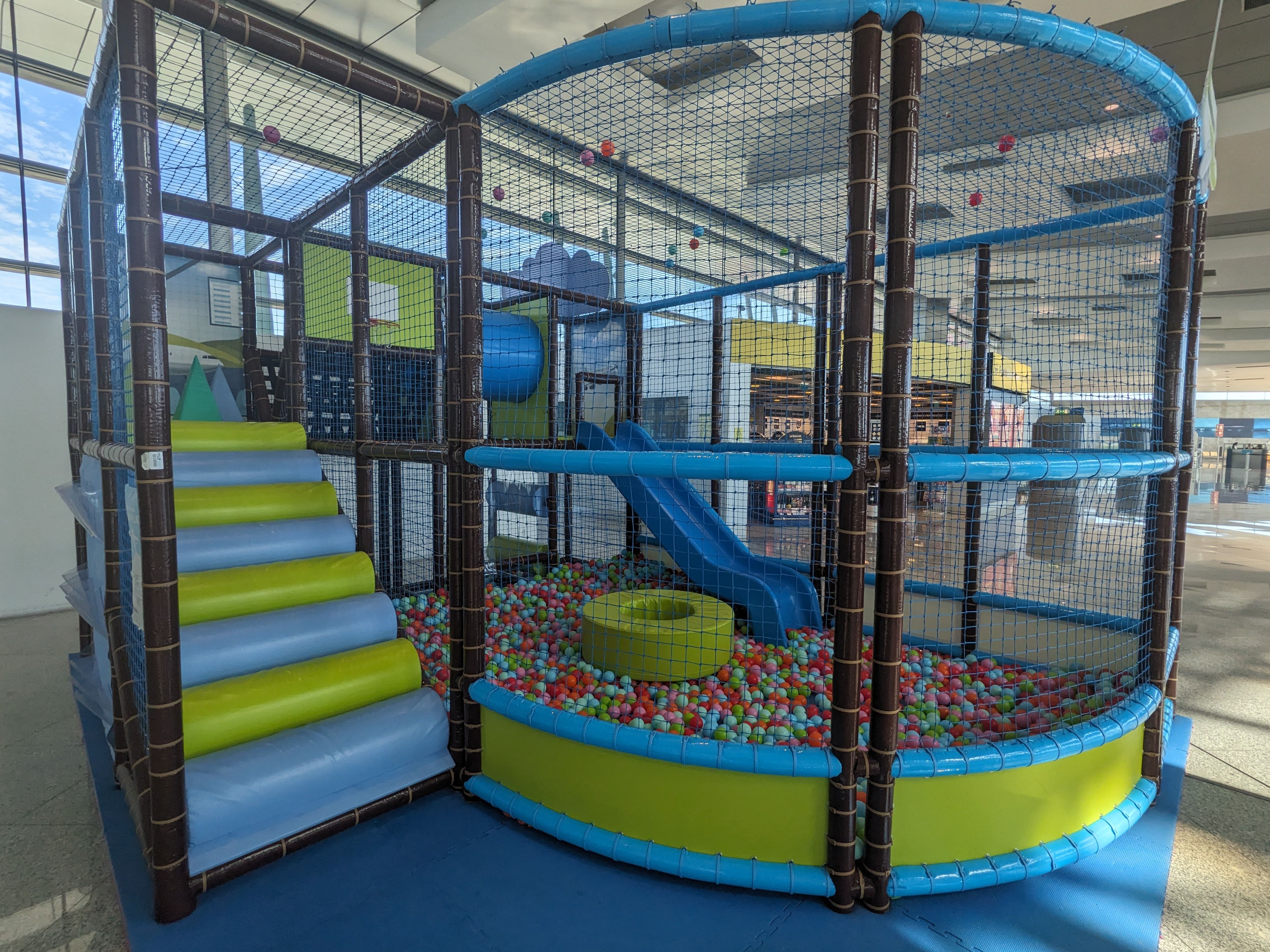
On the return trip, I flew out of Porto (OPO). This is a smaller airport, but one that handles a lot of international flights.
There seemed to be one main lounge, used by all the airlines, and priority pass. Getting in was a bit of an ordeal with a line of 10 or so, and each person taking a few minutes to have their access checked. I suspect the sheer number of access methods created a lot of confusion during the admittance process.
The security process for international travellers was also a bit confusing. First we had to clear regular airport security, and then a customs checkpoint where they stamped our passports. All normal. But then, “boarding” began well before scheduled departure, perhaps 90 minutes. During boarding, we needed to make our way to the gate, then have our passes scanned, and then answer a series of quiz-like questions about our travel. These seem to be related to security.
My exchange went something like this.
- What was the nature of your trip? Leisure.
- Where did you go / what did you see? Lisbon, Porto.
- Where in Lisbon did you go? Mentioned staying near Belém.
- What did you do and see near Belém? Mentioned walking along the river to Belém Tower.
- Belém is known for a particular type of delicacy. What is it? Huh?
At this point there was a bit of back and forth where she tried to get me to name the type of food the Belém neighborhood is known for and the best I could come up with was a description of a local cherry wine called Ginjinha whose name I couldn’t remember at the time. She seemed unfamiliar with the wine, but eventually let me pass without revealing the secret Belém food.
After semi-satisfactorily answering these questions, passengers entered a fenced-off gate side area for another 30 minute wait before being allowed to actually board the plane. This all felt a bit excessive, and it was a bummer to end up waiting so long at the gate when I had lounge access. If memory serves, the “boarding process” ended well before we were allowed to board the plane. Had I stayed in the lounge longer, I might have been denied passage through the pre-boarding checkpoint.
TAP Portugal Flight
I flew back to America via Newark on TAP Portugal where I got a business class ticket for 60k Aeroplan miles plus $100 in fees. The miles were transferred from American Express, and the $100 in fees were covered by my Ritz card’s airline incidental benefit. This flight normally prices between $1,900 and $3,000 making this a 3-5 cent per point redemption.
The plane was an A321neo with lie-flat seats in business. The seats were pretty standard and quite comfortable. Since we left around 6pm and arrived around 9pm in New York, I didn’t sleep on the plane, instead watching a few movies and enjoying the meal service.
Newark (EWR) and Global Entry
Global Entry requires a small fee and a lengthy application process. I have been procrastinating getting it, even though I have it for free through several credit cards. Well, it’s time to stop sleeping on that. When I arrived in EWR, the line to get through customs was around 40 minutes without Global Entry and about 1 minute with it.
After clearing customs, I made my way to Hilton’s airport Double Tree.
DoubleTree by Hilton Hotel Newark Airport
Our hotel is next to Newark Liberty International Airport, with a free shuttle every 30 minutes. We're seven miles from Cape Liberty Cruise Port and 10 miles from New York City. Every stay starts with a chocolate chip cookie, and Starbucks coffee and grab-and-go items are available in the lobby. Enjoy our fitness center and indoor pool.
This was the cheapest points hotel around Newark and it was perfectly ok. They had an airport shuttle that worked well for me, but it was full on each trip to and from the airport, so you might not want to count on it if your schedule is tight. It seems to be in a somewhat sketchy neighborhood, with gated access, and getting an Uber in likely requires coordination with the front desk. Like all Double Trees, Cookies were provided at checkin.
United to Columbus
The final leg of my trip was completed with a morning flight in United first class to Columbus. This cost 19,500 Amex points through the American Express Travel Portal after taking into account the 35% rebate I get from my business platinum card. Since these count as a cash fare, I earned around 1,300 united miles on the flight.
Summary
This was a very enjoyable trip and I wouldn’t hesitate to do europe by rail again. That said, it had an unusually complex cost structure.
Trains - $325 total
- $120 - Barcelona to Madrid
- $125 - Madrid to Badajoz
- $30 - Badajoz to Lisbon
- $50 - Lisbon to Porto
Flights
- 19,500 Amex - United EWR to CMH
- 60,000 Aeroplan + $100 covered by Ritz card - TAP Portugal
Hotels
- 112k IHG - 5 nights in Crowne Plazas (Madrid, Porto)
- 9k Marriott - 1 night Badajoz
- 25k Choice - 1 night in Lisbon
- 66k Hyatt - 4 nights in Lisbon
- 30k Hilton - Newark DoubleTree
If you include travel in part one, making this trip work involved every major points bank and hotel chain, 15 different currencies (points and cash), and a few other things we never discussed.
For all the apparent complexity, it felt really simple, and far less complex than if I had just been invested in 1-2 programs. At each stage, I was just booking with whoever had the most reasonable and most convenient deal.
Explore the rest of this trip.
- Part 1: Sailing from America to Spain’s Gold Coast
- Part 2: Spain and Portugal by Train

